child restraint OLDSMOBILE BRAVADA 1996 Owners Manual
[x] Cancel search | Manufacturer: OLDSMOBILE, Model Year: 1996, Model line: BRAVADA, Model: OLDSMOBILE BRAVADA 1996Pages: 340, PDF Size: 17.49 MB
Page 18 of 340
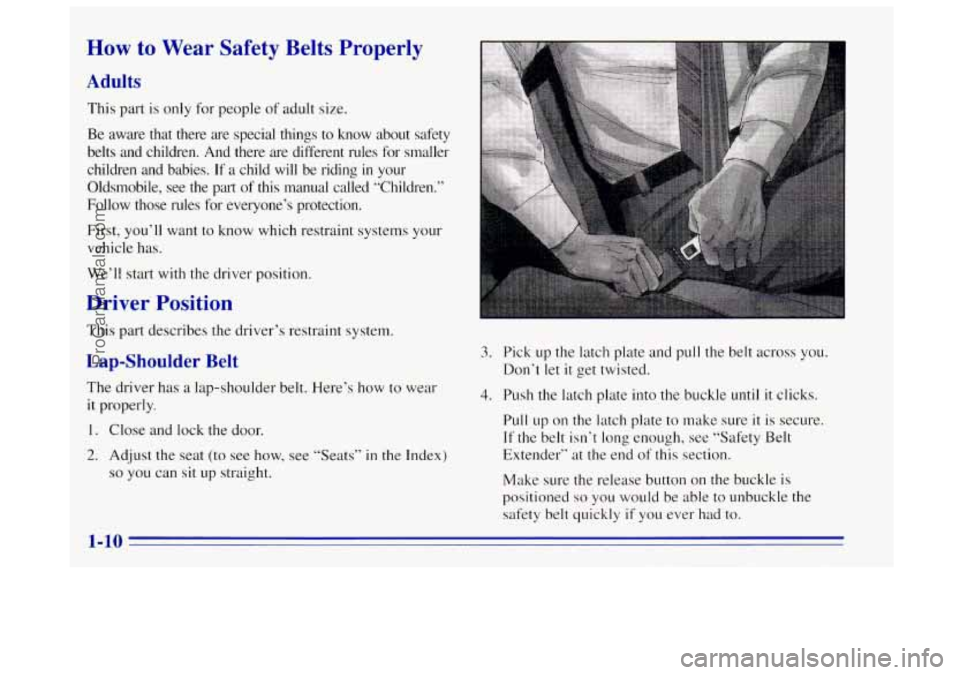
How to Wear Safety Belts Properly
Adults
This part is only for people of adult size.
Be aware that there are special things to know about safety
belts and children. And there are different rules for smaller
children and babies. If
a child will be riding in your
Oldsmobile, see the part
of this manual called “Children.”
Follow those rules for everyone’s protection.
First, you’ll want to know which restraint systems your
vehicle has.
We’ll start with the driver position.
Driver Position
This part describes the driver’s restraint system.
Lap-Shoulder Belt
The driver has a lap-shoulder belt. Here’s how to wear
it properly.
1. Close and lock the door,
2. Adjust the seat (to see how, see “Seats” in the Index)
so you can sit up straight.
..... 1. ... .. .+.. 7 _: . : .......... .:
3. Pick up the latch plate and pull the belt across you.
Don’t let
it get twisted.
4. Push the latch plate into the buckle until it clicks.
Pull up on the latch plate to make sure it is secure.
If the belt isn’t long enough, see “Safety Belt
Extender” at the end
of this section.
Make sure the release button on the buckle is
positioned
so you would be able to unbuckle the
safety belt quickly
if you ever had to.
1-10
ProCarManuals.com
Page 34 of 340
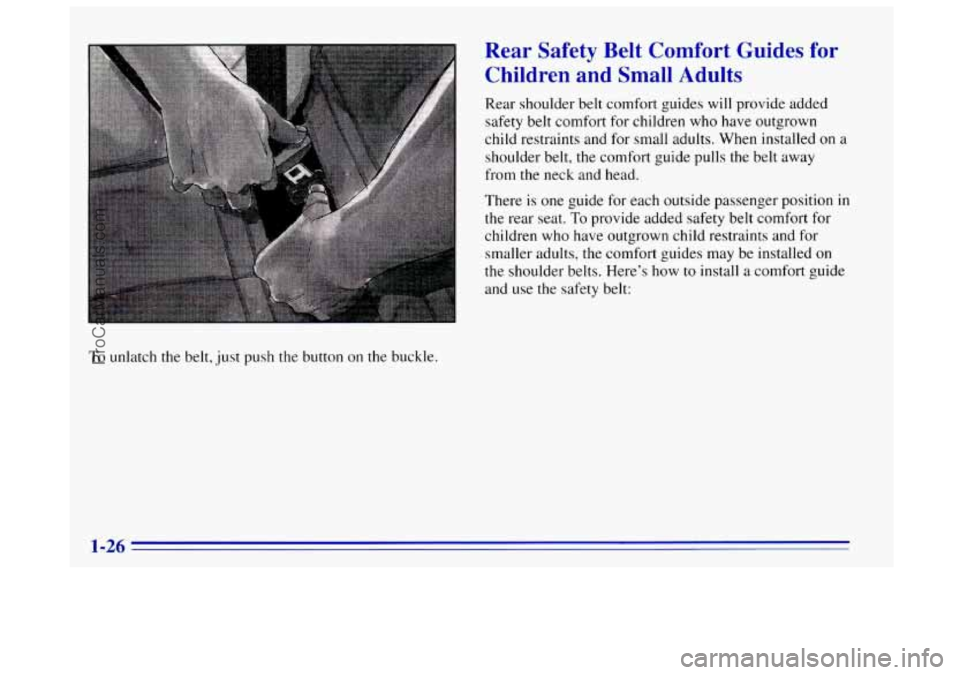
~~~ ~ To unlatch the belt,
just push the button on the buckle.
Rear Safety Belt Comfort Guides for
Children and Small Adults
Rear shoulder belt comfort guides will provide added
safety belt comfort for children who have outgrown
child restraints and for small adults. When installed on
a
shoulder belt, the comfort guide pulls the belt away
from the neck and head.
There is one guide for each outside passenger position
in
the rear seat. To provide added safety belt comfort for
children who have outgrown child restraints and for smaller adults, the comfort guides may be installed on
the shoulder belts. Here’s how
to install a comfort guide
and use the safety belt:
ProCarManuals.com
Page 38 of 340
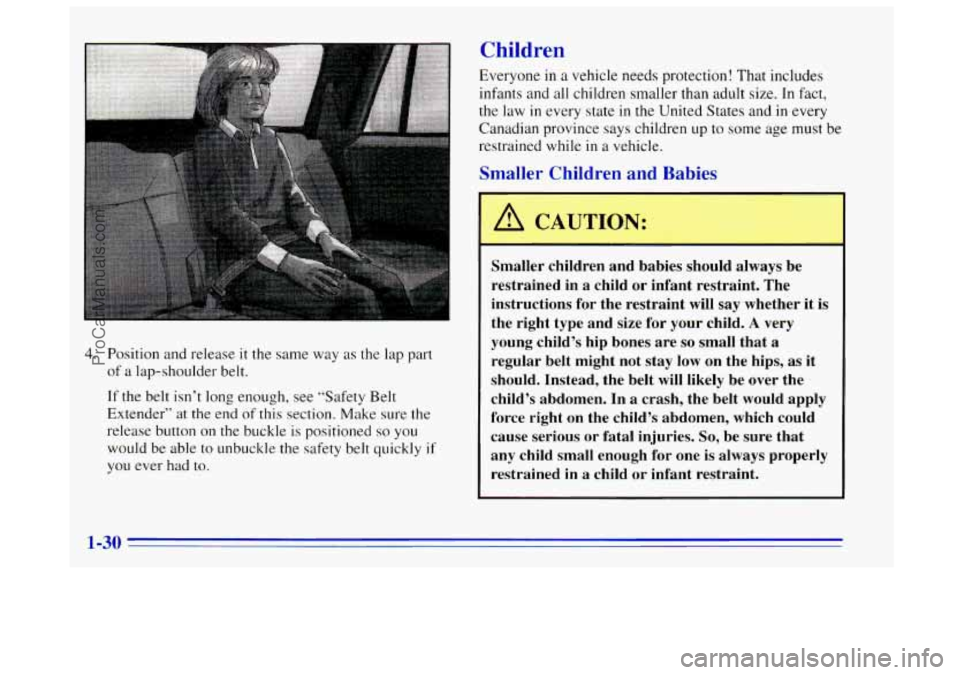
Children
4. Position and release it the same way as the lap part
of a lap-shoulder belt.
If the belt isn’t long enough, see “Safety Belt
Extender” at the end
of this section. Make sure the
release button
on the buckle is positioned so you
would be able to unbuckle the safety belt quickly
if
you eves had to. Everyone
in
a vehicle needs protection! That includes
infants and all children smaller than adult size. In fact,
the law
in every state in the United States and in every
Canadian province says children up to some age must be
restrained while in a vehicle.
Smaller Children and Babies
A CAUTION:
Smaller children and babies should always be
restrained in a child or infant restraint. The
instructions for the restraint will say whether it is
the right type and size for your child.
A very
young child’s hip bones are
so small that a
regular belt might not stay low on the hips, as it
should. Instead, the belt will likely be over the
child’s abdomen. In a crash, the belt would apply
force right
on the child’s abdomen, which could
cause serious or fatal injuries.
So, be sure that
any child small enough for one
is always properly
restrained in a child or infant restraint.
1-30
ProCarManuals.com
Page 40 of 340
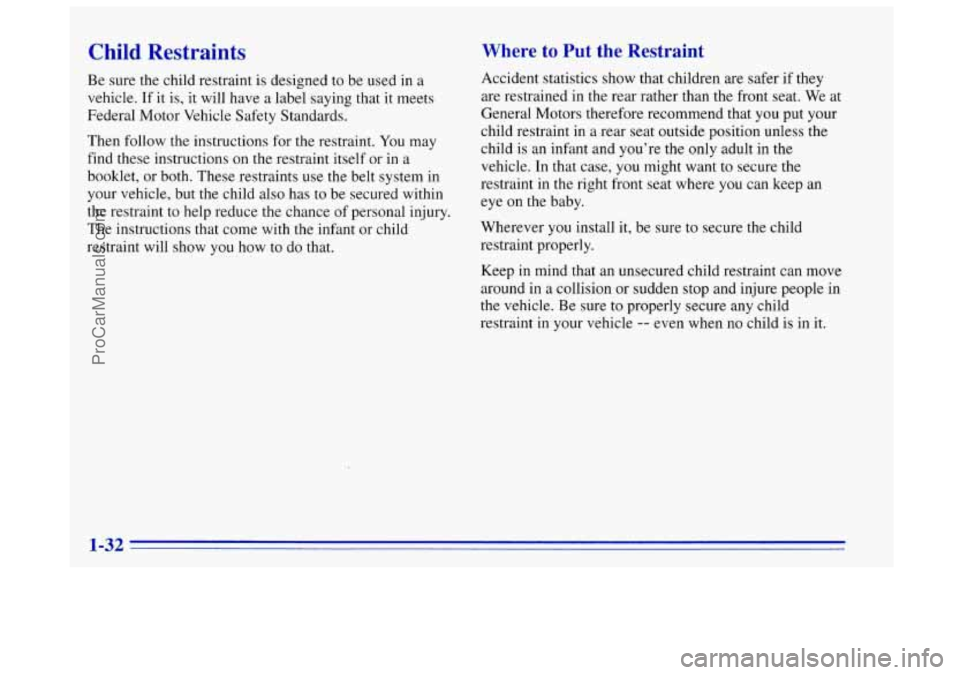
Child Restraints
Be sure the child restraint is designed to be used in a
vehicle.
If it is, it will have a label saying that it meets
Federal Motor Vehicle Safety Standards.
Then follow the instructions for the restraint. You may
find these instructions on
the restraint itself or in a
booklet, or both. These restraints use
the belt system in
your vehicle, but the child also has to be secured within
the restraint to help reduce the chance of personal injury.
The instructions that come with the infant or child
restraint will show you how to do that.
Where to Put the Restraint
Accident statistics show that children are safer if they
are restrained
in the rear rather than the front seat. We at
General Motors therefore recommend that you put your
child restraint in a rear seat outside position unless the
child is an infant and you’re the only adult in the
vehicle.
In that case, you might want to secure the
restraint in the right front seat where you can keep an
eye on
the baby.
Wherever
you install it, be sure to secure the child
restraint properly.
Keep
in mind that an unsecured child restraint can move
around in a collision or sudden stop and injure people in
the vehicle. Be sure
to properly secure any child
restraint in your vehicle
-- even when no child is in it.
ProCarManuals.com
Page 41 of 340
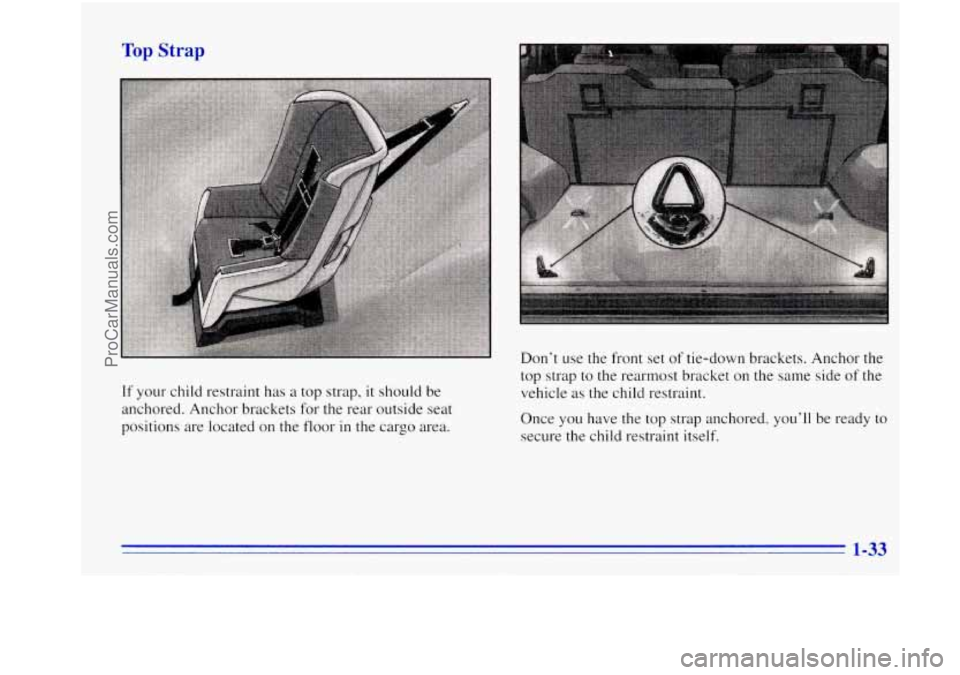
Top Strap
If your child restraint has a top strap, it should be
anchored. Anchor brackets for the rear outside seat
positions are located on the
floor in the cargo area. Don’t
use the front set
of tie-down brackets. Anchor the
top strap to the rearmost bracket on the same side of the
vehicle as the child restraint.
Once you have the top strap anchored,
you’ll be ready to
secure the child restraint itself.
ProCarManuals.com
Page 42 of 340
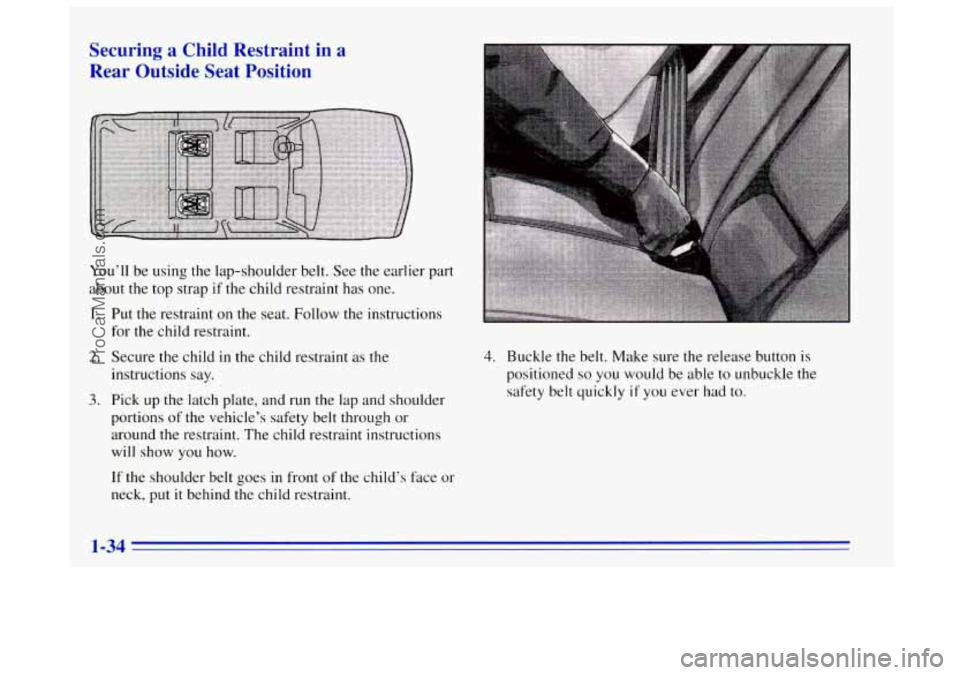
Securing a Child Restraint in a
Rear Outside Seat Position
You’ll be using the lap-shoulder belt. See the earlier part
about the top strap
if the child restraint has one.
1.
2.
3.
Put the restraint on the seat. Follow the instructions
for the child restraint.
Secure
the child in the child restraint as the
instructions say.
Pick up the latch plate, and run the lap and shoulder
portions
of the vehicle’s safety belt through or
around the restraint. The child restraint instructions
will show you how.
If the shoulder belt goes in front of the child’s fixe or
neck, put it behind the child restraint.
4. Buckle the belt. Make sure the release button is
positioned
so you would be able to unbuckle the
safety belt quickly
if you ever had to.
ProCarManuals.com
Page 43 of 340
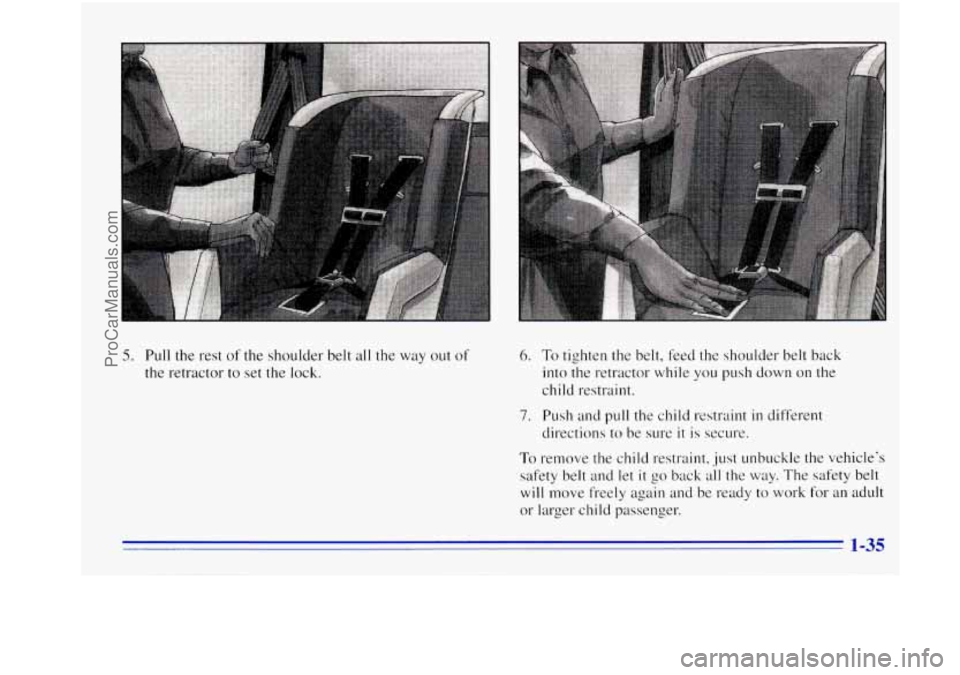
5. Pull the rest of the shoulder belt all the way out of
the retractor to set the lock.
6. To tighten the belt, feed the shoulder belt back
into the retractor while you push down on the
child restraint.
7. Push and pull the child restraint in different
directions to be sure
it is secure.
To remove the child restraint, just unbuckle the vehicle's
safety belt and let
it go back a11 the way. The safety belt
will move freely again and be ready to work for
an adult
or larger child passenger.
ProCarManuals.com
Page 44 of 340
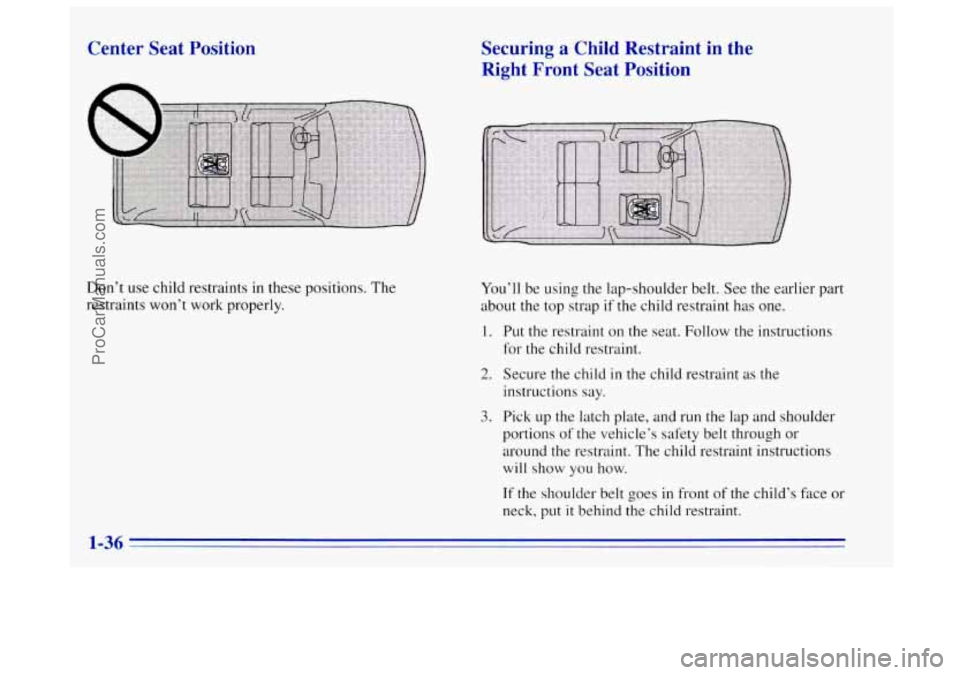
Center Seat Position
Don’t use child restramts in these positions. The
restraints won’t work properly.
Securing a Child Restraint in the
Right Front Seat Position
You’ll be using the lap-shoulder belt. See the earlier part
about the top strap
if the child restraint has one.
1. Put the restraint on the seat. Follow the instructions
for the child restraint.
2. Secure the child in the child restraint as the
instructions say.
3. Pick up the latch plate, and run the lap and shoulder
portions
of the vehicle’s safety belt through or
around the restraint. The child restraint instructions
will show
yo~l how.
If the shoulder belt goes in front of the child’s face or
neck, put
it behind the child restraint.
1-36
ProCarManuals.com
Page 46 of 340
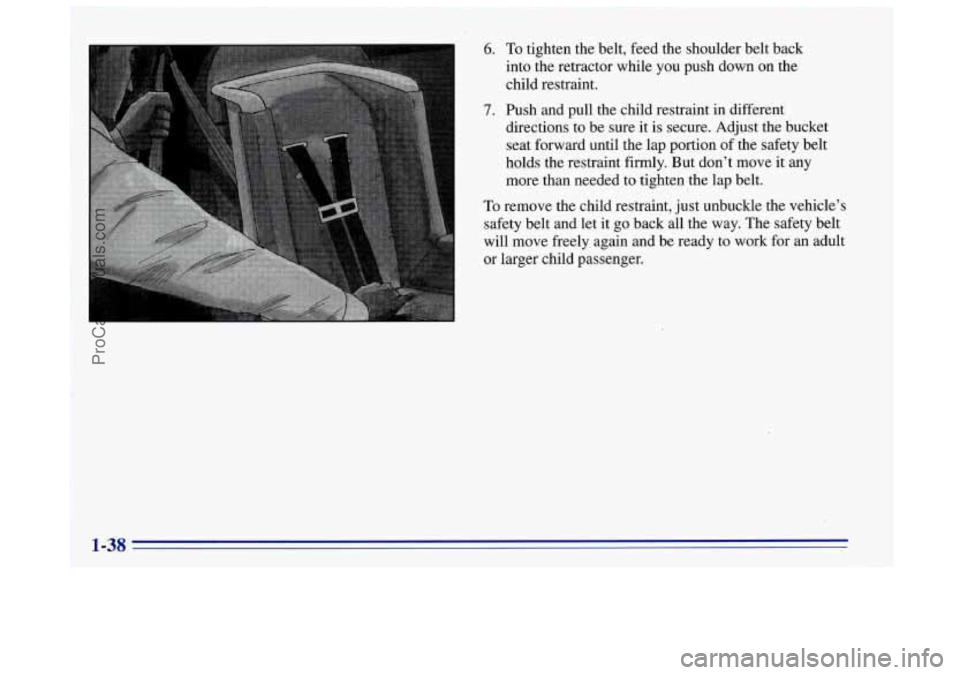
6. To tighten the belt, feed the shoulder belt back
into the retractor while you push down on the
child restraint.
7. Push and pull the child restraint in different
directions to be sure it is secure. Adjust the bucket
seat forward until the lap portion of the safety belt
holds the restraint firmly. But don’t move it any
more than needed to tighten the lap belt.
To remove the child restraint, just unbuckle the vehicle’s
safety belt and let it
go back all the way. The safety belt
will move freely. again and be ready to work for an adult
or larger child passenger.
ProCarManuals.com
Page 47 of 340
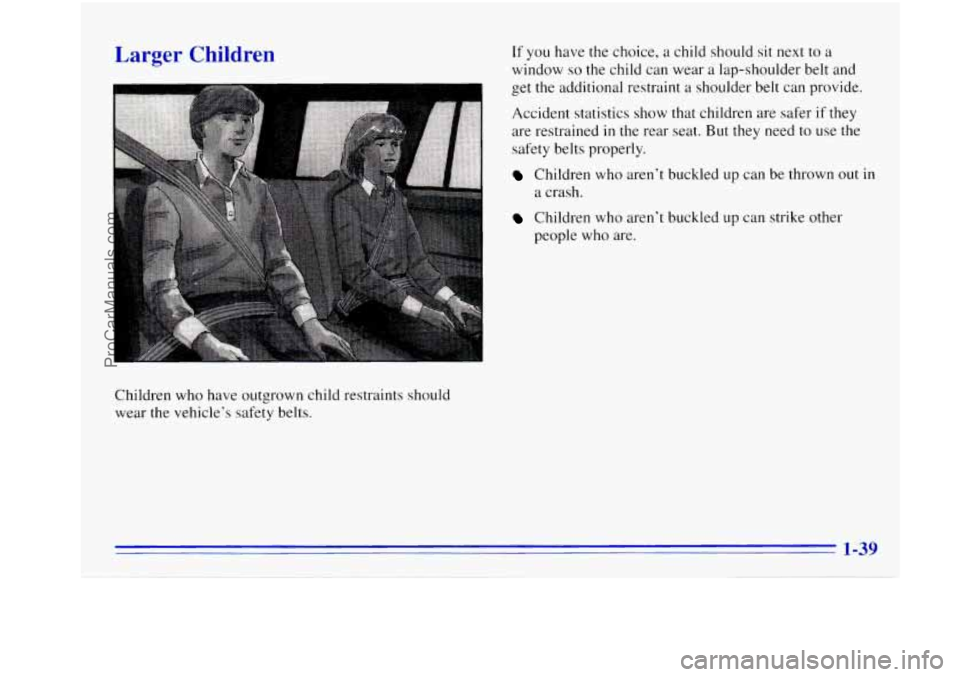
Larger Children
Children who have outgrown child restraints should
wear the vehicle’s safety belts.
If you have the choice, a child should sit next to a
window
so the child can wear a lap-shoulder belt and
get the additional restraint
a shoulder belt can provide.
Accident statistics show that children are safer if they
are restrained
in the rear seat. But they need to use the
safety belts properly.
Children who aren’t buckled up can be thrown out in
a crash.
Children who aren’t buckled up can strike other
people who are.
ProCarManuals.com